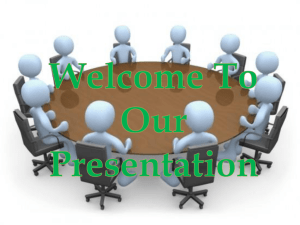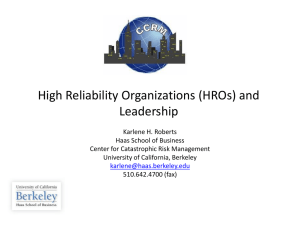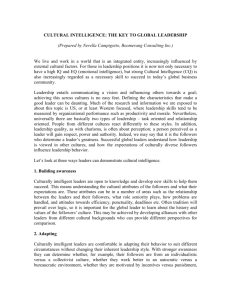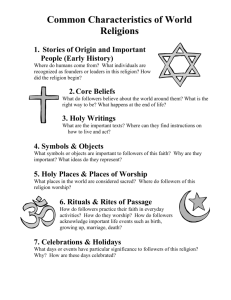NIOB E-Leadership Paper - Nigerian Institute of Building
advertisement
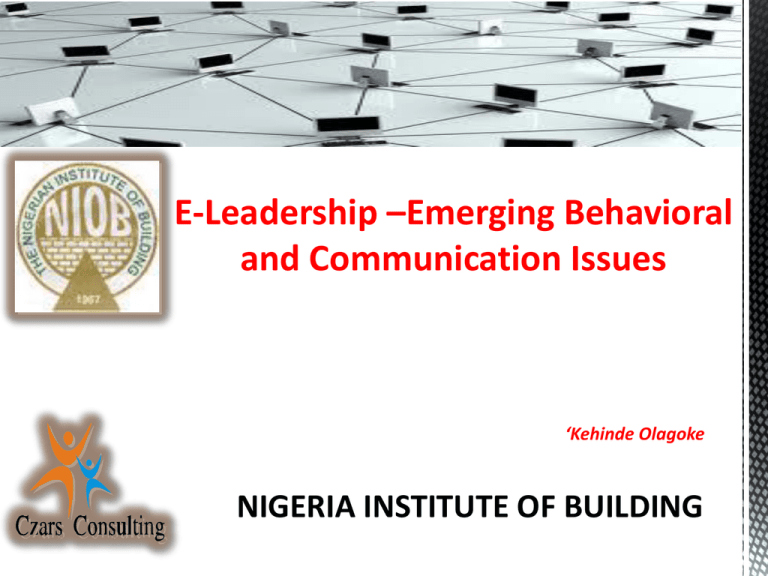
E-Leadership –Emerging Behavioral and Communication Issues ‘Kehinde Olagoke NIGERIA INSTITUTE OF BUILDING Have a Vision Harness the Talent and skills of Team members and clients Communicate & Articulate the Vision to Team members and your clients Delegate Function Monitor Progress, Mentor Team/Followers/Clients Motivate by rewarding achievements and reprimanding failure to meet the challenges of the clients. Now significant human interactions are mediated through information technology to produce new organizational form and new work environment termed E-environment and the emerging leadership is labeled as E-leadership or Electronic leadership The goals of leadership have not changed , but the eleader needs to implement those goals electronically through computer mediated virtual teams that are dispersed over space and time . Leadership patterns are beginning to reflect transition from industrial to post-industrial society. The new society variously called information society, is marked by rapid and far reaching changes in digitalization of information and communication technology. The use of information technology over the years has been altering the way organizations are Conducting their business. As a result new organizational form -virtual organization - has emerged. Leader and followers now communicate through E-technologies (telephone, e-mail, chat social media and video-conferencing etc). Instant direct communication with employees, customers, suppliers and stakeholders . Access to clients irrespective of location Enhancement of organizational performance by making use of multi-functional teams Cost Reduction Access to information/greater workforce connectivity Rapid response to customers demands Increased or Improved Bottom-line as competitive advantage is enhanced Bridging the physical distance between the leader, his team and clients. Communicating effectively with widespread team members who in turn make it simple for the clients. Conveyance of enthusiasm and inspiration to followers and clients electronically Building of Trust with team members and the clients you don’t see Adaptive Structuration Theory - Human actions are guided by structures: Structures are rules and resources that serve as templates for planning and accomplishing tasks . Technology creates organizational structures of which leadership is a part. Leadership and technology have a recursive relationship . Be prepared Develop New Skills Be adaptable to Change/Flexible Learn to Re-learn Learn to Motivate Learn to Build Trust Understand the value of e-technologies Experiment with ideas Comunication is key in e-leadarship. It takes place through information technology. Could be verbal, non verbal, Visual , non Visual etc The basic responsibilities of the leader do not change; the only thing that change is how the leader can communicate with his people effectively while they are not at the same office building. Beliefs/Perception Information Overload Assumption Knowing when to replace traditional work processes with virtual ones Learn about cultural differences, if these could pose problems Avoid the use of Jargons Avoid language that is confrontational or Judgmental AnalysisUnderstandingDemographics- Who is the audience ? What is the audience’s Knowledge of the subject What is their age , gender , educational background InterestWhy are they listening to me ? Environment- Where will this document be /presented Needs How can I meet the needs of the audience Customization - How can I tailor my work to meet their needs? Expectations What would they learn from my presentation Note that the results of your audience analysis that will determine the tool/channel of communication Email Internet Forum Discussion Boards Weblogs RSS (Really Simple Syndication) Social Networking e.g Facebook, Yammer, Twitter, etc Conferencing Tools (Video or Telephone) e.g Skype Online Chat eg. Yahoo Messenger, Blackberry Flash meeting Application/Desktop sharing Intranet A fairly informal business correspondence with a set of rules called Netiquette, Digital manners etc. Be Concise and Unambiguous Be clear and Direct in the Subject Line Never think your email is totally Confidential If this is made public , would you be comfortable ? Do not torture your readers with abbreviations Use Uppercase for emphasis Only Don’t start with Dear Sir/Madam Use Informal Closing Don’t send one word emails Save a tree ! Use the address fields with care Politely Sign your messages



